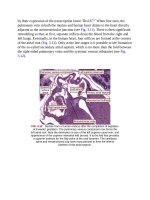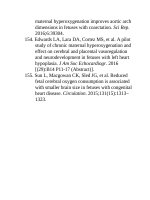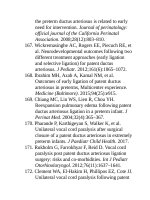Andersons pediatric cardiology 1060
Bạn đang xem bản rút gọn của tài liệu. Xem và tải ngay bản đầy đủ của tài liệu tại đây (206.65 KB, 3 trang )
FIG.40.5 Left,Dysplasticleafletsofthecommontruncalvalveclosedon
thecrestoftheventricularseptumduringventriculardiastole;thecrest
itselfisthickenedbyfibroustissue.However,aninterventricular
communicationremainsduringventricularsystole.Notethepersistently
patentarterialduct.Thishearthasabalancedarrangementofthe
intrapericardialcomponentsoftheaortaandthepulmonarytrunk.Right,In
contrast,thistrunkarisesexclusivelyfromtherightventricle,andthe
ventricularseptumisintact.Thishearthasaorticdominancebutwitha
confluentpulmonaryarterialsegment.
Thetruncalvalvehasthreeleafletsinapproximatelytwo-thirdsofpatients.In
mostoftheremainingpatients,eithertwoorfourleafletsareseenguardingthe
commonarterialorifice.Theleafletsarealmostalwaysinfibrouscontinuitywith
theanterosuperiorleafletofthemitralvalve(seeFig.40.3,left),buttherecanbe
acompletelymuscularsubtruncalinfundibulum,particularlywhenthecommon
trunkarisesexclusivelyfromtherightventricle(seeFigs.40.3,right,and40.5,
right).Insufficiencyofthetruncalvalveisnotuncommonandcanbecausedby
thickenedanddysplasticleafletsorbyprolapseofunsupportedleafletsasa
resultofdilationoftheventriculoarterialjunction.Truncalvalvarstenosisis
relativelyuncommon.Whenpresent,itisusuallybecausethevalvarleafletsare
dysplastic.
Thegreatestanatomicvariabilityisfoundinthepatternofthebranchingof
thecommontrunk.Thepresenceofaright-sidedaorticarch,withmirror-imaged
branchingofthebrachiocephalicarteries,isassociatedmoreoftenwithcommon
trunk,occurringinuptoone-thirdofpatients,thanwithanyothercongenital
cardiacmalformation.Hypoplasiaoftheaorticarch,withorwithoutcoarctation,
isaparticularlyimportantassociatedfindingbutislessfrequentthancomplete
interruptionofthearch.Suchinterruptionisoneofthemajorsubgroups
recognizedinthealpha-numericsystemthatwassuggestedbyVanPraaghand
VanPraaghforclassification.8However,itisbettertofollowthesuggestion
madeinitiallybytheVanPraaghs,namelytocategorizethedefectsintermsof
aorticorpulmonarydominanceofthecommontrunk.
Whenthearchisinterrupted,thepersistentlypatentarterialductfeedsthe
descendingthoracicaortaandpartofthebrachiocephaliccirculation,theprecise
proportiondependingonthesiteofinterruption.Aswithotherformsof
interruptionoftheaorticarch(seeChapter45),retroesophagealoriginofthe
rightsubclavianarteryisfrequentlyseen.Apartfromthoseheartswithsevere
coarctationorinterruption,orinwhichthepulmonaryarteriesarediscontinuous,
andoneisfedthroughapatentduct,itisraretofindductalpatencycoexisting
withcommonarterialtrunk,althoughitdoesexist(seeFig.40.5,left).9Thestate
oftheaorticarchispossiblythemostsignificantclinicalassociated
malformationfoundwithcommonarterialtrunk.Itwasthearrangementof
originofthepulmonaryarteries,followingthesystemproposedbyCollettand
Edwards,whichwas,inthepast,mostfrequentlyusedfornumeric
classification.5Thissystemlargelyaccountsforaorticdominance,withthe
pulmonaryarteriestypicallyarisingfromtheleftposterolateralaspectofthe
aorticdominantcommontrunk,takingoriginashortdistanceabovethetruncal
valve.Onoccasion,theycantaketheirorigindirectlyfromatruncalarterial
valvarsinus.However,thearrangementinwhichtherightandleftarteriescan
takeseparateoriginfromtheposterioraspectofthetrunk,producingthesocalledtypeIIIvariantisthepatternfoundwithpulmonarydominance(Fig.40.6,
right).Describingaorticdominanceandprovidingaprecisedescriptionforthe
originofthepulmonaryarteriesnegatetheneedtoresorttodescribing“typeone
andone-half.”Inthisregard,itispossibletofindexamplesinwhichonlyone
pulmonaryarteryarisesfromthecommontrunk,theotherbeingsupplied
initiallythroughaductthatbecameligamentous.Intheclinicalsetting,thiscan
presentas“unilateralabsence”ofonepulmonaryartery,butalmostalwaysthe
“absent”arteryisidentifiedwithinthehilumofthelung.Whenthisarrangement
isfoundwithcommontrunk,thediscontinuouspulmonaryarteryinitiallyfedby
theductismostfrequentlyonthesamesideastheaorticarch.Thisisincontrast
tothefindinginpatientswithtetralogyofFallotwhenonepulmonaryarteryis
absentbecauseinthissettingthediscontinuousarteryismorefrequentlyonthe
sideoppositetheaorticarch.Insomecircumstances,thepulmonaryartery
feedingtherightlungistotheleftatitsoriginfromthecommontrunkrelativeto
thearteryrunningtotheleftlung.Thetwoarteriesspiralastheyextendtothe
pulmonaryhilums.Thisentityiscalled“crossedpulmonaryarteries.”Itisalso
possibleforonepulmonaryarterytoarisedirectlyfromtheascendingaorta,
whereastheothertakesitsoriginfromtherightventricle.Somecallthis
malformation“hemitruncus.”Thisisincorrectbecause,ofnecessity,thehearts
haveseparateventriculoarterialjunctions,guardedbyseparateaorticand
pulmonaryarterialvalves.Theycannotthereforebeexamplesofcommon
arterialtrunk.
FIG.40.6 Accordingtothepatternofbranchingofthecommontrunk,
casescanusuallybedescribedintermsofaortic(left)orpulmonary(right)
dominance.Notetheinterruptionoftheaorticarch(star)intheheartshown
atright,withretroesophagealorigintherightsubclavianartery.Inrare
circumstances,therecanbeabalancedpatternofbranching(seeFig.
40.5,left).VSD,Ventricularseptaldefect.
Anomaliesoftheoriginanddistributionofthecoronaryarteriesare
frequent.10Unlikethesituationwhenthereareseparateaorticandpulmonary









